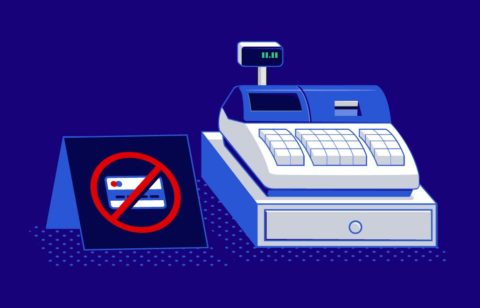According to recent data from Experian, the average American carries approximately three credit cards. This number varies by generation with Gen Z consumers carrying 1.8 cards on average and Baby Boomers carrying an average of 4.8 cards. Another Experian report indicates that Americans carry an average credit card balance of $5,589. It’s easy to fall into credit card debt when you can’t afford to pay off your balance, but there are ways to overcome this.
How much are your credit cards costing you?
Have you ever sat down to determine how much money your credit cards are taking out of your pocket? You might be shocked by the results. For example, let’s suppose you have three credit cards. One has a balance of $4,000 at 18%, the second has a balance of $7,000 at 19%, and you owe $3,500 at 20% on the third. In total, this equals an average interest rate of 19% and a whopping debt total of $14,500.
To make things simpler, let’s look at the average interest and the total balance owed by adding up the three separate cards. We will also assume you want to get the $14,500 paid off in three years. In this case, you would have a monthly payment of $531.51 and pay a total of $4634.44 in interest charges on a combined balance of $14.500, or nearly 32% of your total debt.
Turning the tables on credit card companies
If you’re frustrated paying high interest on your credit card debts, take heart. You could potentially turn the tables on the credit card companies, but it requires a large amount of self-discipline along with the right strategy. Knowing how to successfully manage multiple cards is key.
Credit card “islands”
The “island approach” entails designating each credit card for a different category of purchases. Many cards offer rewards—some give you points for groceries while others let you earn cash back at the gas pump. Depending on the credit card, you might earn 6% cash back on groceries, 3% cash back on certain department stores, 5% on gas purchases and maybe 2% on everything else.
While this can be a good way to use credit cards, it pays to be careful and read the fine print. One card can initially provide a sign-up bonus, but it might not be enough to offset the annual fee. The strategy over time is to have the best rewards card for each group of major purchases and to pay off the balance in full every month.
Using multiple credit cards can lead to trouble
Owning multiple credit cards can do more harm than good if they aren‘t managed properly. When signing up for a new card, evaluate your track record of making timely payments and be sure not to overextend yourself. Strategy and discipline are essential when using methods like the island approach. Therefore, it’s important to take your financial situation into consideration when juggling multiple credit cards.
The downside of having multiple credit cards
If you plan on buying a new car or getting a mortgage in the next few years, managing your credit wisely is critical for approval and locking in the best interest rate.
Problems with a credit card might not show up today but when it’s time to make a major purchase, you could be hit with a slightly higher interest rate. For example, if you took out a mortgage with a rate that was half a point higher due to your credit history, it would cost you thousands of dollars in extra interest over the life of the loan.
Play the balance transfer credit card game
Another way to turn the tables on credit card companies is by using balance transfers. Virtually every credit card issuer today offers 0% interest balance transfer cards for a limited amount of time. You could transfer your balances on any high-interest credit cards to a new one and pay no interest anywhere from 6 -21 months. Since you’ll only be paying the principal during that time, you can pay off your debt faster.
The best thing you can do is use this interest-free introductory period to completely pay off your balance. If that’s impossible, you can also transfer the balance on the new card to yet another 0% interest card. If you were to do this with three different cards, each of which offered a 12-month 0% introductory interest rate, you could avoid paying any interest for 36 months. Since all those transfers could impact your credit score, this isn’t an ideal solution.
People Also Read
Tips for handling a credit card sensibly
If your goal is to have a good credit score, you should avoid any of the tactics mentioned above. Instead, make sure you handle your credit card(s) responsibly and follow these four tips:
1. Use the card only when needed
You shouldn’t view a credit card as a magic wand used to pay for those “fun” impulse purchases—especially if you are already struggling with debt. If you decide to use your card often, make sure you can pay off the full balance on time. Otherwise, don’t use it unless it’s an emergency.
2. Monitor how you use the card
If you have multiple cards, set a reminder on your computer or smartphone to ensure you make all your payments on time. Missing just one payment could bump you up to a higher interest bracket. The same holds true if you were to exceed your credit limit.
Autopay is offered by most credit card issuers and provides a simple way for you to avoid late fees. Your balance or minimum payment is automatically deducted from a designated bank account when your statement is posted. Simply set the pay date and forget it.
3. Pay off your balance(s) every month
This practice enables you to avoid interest charges and late fees entirely. If you are unable to pay off your balance, consider seeking help from a credit counselor or a debt management program that can help get your spending under control.
4. Keep track of your interest rate
If you take out a card with a low introductory interest rate, be aware that it may go through the roof when that introductory period expires. Check your statements every month to ensure you’re getting the terms you agreed to. If you see that your interest rate has taken a huge leap upward, try to pay off your balance as quickly as possible. In dire situations, you can transfer the balance to another 0% interest card.
If you can’t afford it, you shouldn’t buy it. So, the next time you pull out that plastic for something you don’t really need, do yourself a favor and think about how you can use that money to pay off your debt instead.









